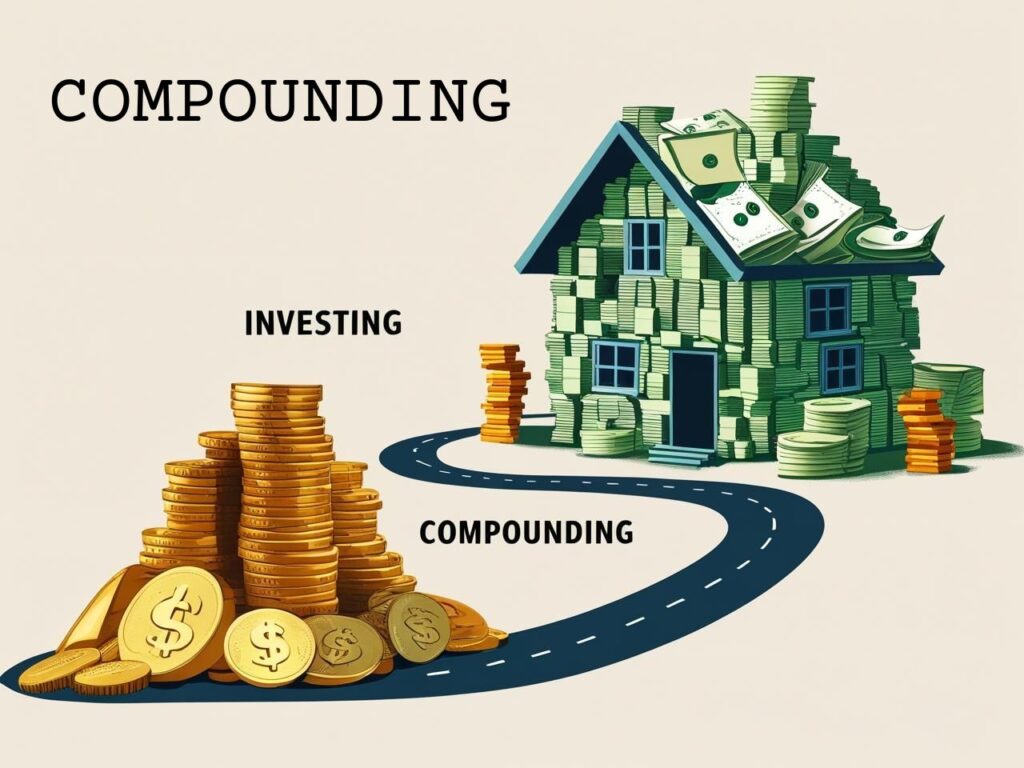SEE TABLE OF CONTENTS
Table of Contents
What Investing Is? For Beginners
Investing means putting your money into assets that can grow in value over time. These assets might include stocks, gold, silver, real estate, or even small businesses. Instead of leaving your money idle in a savings account where it barely grows, you allow it to generate potential profits by placing it in different options.

If you’re a beginner, don’t worry. Getting started with building financial security doesn’t require a finance degree. It just takes a bit of curiosity and discipline. Even small amounts, when used wisely, can go a long way. The earlier you start, the better results you can expect, thanks to the power of growth over time.
Why Should We Do It? Need of Investing
Earning money through jobs or businesses is great, but inflation constantly reduces its real value. A fixed amount today may not buy the same things tomorrow. That’s why allocating money to financial assets is necessary.
Here are key reasons to start building wealth:
- Wealth Creation: Capital placed in financial assets can appreciate over time.
- Inflation Shield: Assets like equities or gold tend to outpace inflation in the long run.
- Goal-Based Growth: Buying a house, paying for higher education, or retirement all require long-term planning.
- Passive Income: Some methods, like dividends or rent, can provide steady income.
- Financial Independence: A structured plan can help you stop relying solely on active income and gain more freedom.
Types/Ways of Investing
There are several major ways to grow your savings. Each option offers different levels of risk, return, and accessibility.
Stock Market:
- By purchasing shares of companies, you become a part-owner.
- It offers high return potential, but comes with market fluctuations.
- You can use charts, technical and fundamental analysis to study stock performance.
- Historical data shows that consistent, long-term strategies deliver strong results.
Commodities – Gold & Silver:
- You can invest in gold and silver either physically or digitally.
- These precious metals act as a hedge during uncertain economic times.
- Particularly, gold tends to rise when traditional markets fall.
Real Estate:
- Buying land or property is a popular long-term asset class.
- You can earn from rental income or appreciation in property value.
- Though it usually requires more upfront capital, it offers tangible security.
Each type of asset has its own characteristics, so it’s essential to find what suits your financial goals and risk appetite.
Essentials of Investing
Before jumping in, take time to learn the basics and prepare yourself:
- Goal Setting: Know why you’re investing. Clarify your reason—retirement, buying a car, or a safety net.
- Risk Awareness: Know what risks come with each asset class. Every investment has a risk. Learn about it.
- Diversification: Don’t put all your money into one type of investment. Spread your capital across different areas to reduce risk.
- Planning: Plan your budget, duration, and strategy. Map out how much you can allocate monthly and for how long.
- Continuous Learning: Follow economic news, websites, and read helpful books.
- Patience: Growth often takes time. Stay consistent and avoid panic decisions.
How to Do Investing in Stock Market
Here’s a step-by-step guide for newcomers:
- Open a Demat & Trading Account: These accounts hold and manage your shares.
- Choose a Reliable Broker: Look for low fees, a good platform, and reputation.
- Research Companies: Study financials, business models, and performance history.
- Use Analytical Tools: Charts, moving averages, and trends help you make informed choices.
- Start with a Small Amount: Get comfortable with the process before increasing exposure.
- Hold for the Long Term: Avoid chasing quick profits.
- Monitor Periodically: Check your portfolio and make necessary adjustments.
New-age apps and platforms make it extremely easy for anyone to start directly from their phone.
What is Compounding in Investing? How it benefits?
Compounding refers to the process where the earnings on your capital begin to earn returns themselves. It’s essentially interest on interest.

Let’s take an example. You invest ₹10,000 and earn 10% annually. After the first year, you earn ₹1,000, making your capital ₹11,000. The following year, you earn interest on ₹11,000, not just the original amount. Over 10–20 years, this can exponentially grow your portfolio.
This is why starting early and staying invested for a long time are crucial for building serious wealth. Compounding favors those who stay the course.
Difference Between Investing and Trading
It’s common to mix these two, but they have key distinctions:
| Factor | Investing | Trading |
|---|---|---|
| Time Horizon | Several years | Hours to weeks |
| Purpose | Gradual wealth creation | Quick profit opportunities |
| Risk Level | Moderate (declines with time) | High due to volatility |
| Approach | Focus on business fundamentals | Technical analysis using charts |
| Time Required | Minimal after buying | Daily involvement |
If your goal is long-term stability and minimal daily effort, then a structured plan may suit you better.
Pros and Cons of Investing
Advantages:
- Encourages consistent wealth building
- Aligns with future financial goals
- Takes advantage of compounding
- Can provide alternate income streams
- Enhances overall financial security
Disadvantages:
- Returns are not assured
- Emotional decision-making can lead to losses
- Requires upfront research and education
- Results take time to show
Ways to Learn and Improve Skills
Knowledge is your best tool. Here are effective learning methods:
- Books: Read classics like “The Intelligent Investor,” “Common Stocks and Uncommon Profits,” and “Rich Dad Poor Dad.”
- Online Platforms: Follow sites like Zerodha Varsity, Moneycontrol, and Investing.com for updated insights.
- YouTube Channels: Many creators explain concepts using simple visuals.
- Demo Accounts: Use apps that offer mock trading to test strategies.
- Webinars and Online Courses: Enroll in structured courses for in-depth knowledge.
- Join Communities: Forums and groups let you learn from experienced individuals.
Learning is a continuous journey. Every decision you make should be backed by sound understanding.
Conclusion: Future of Investing. What Lies Ahead?
Technology, rising awareness, and access to financial tools have democratized the way people grow their wealth. Today, even someone with limited savings can start planning for a better future.
Whether you’re looking to invest in stock market, allocate funds to gold or explore real estate options, the barriers to entry have lowered significantly. Mobile apps, zero-brokerage platforms, and real-time information make decision-making more convenient than ever before.
The earlier you start, the more benefits you can extract from compounding and long-term returns. Make your goals clear, create a suitable roadmap, and stick to your plan. In this journey, consistency beats speed.
In today’s world, not investing is a bigger risk than investing. So take that first step, make a smart investing plan, and let your money work for you.
Happy Investing!